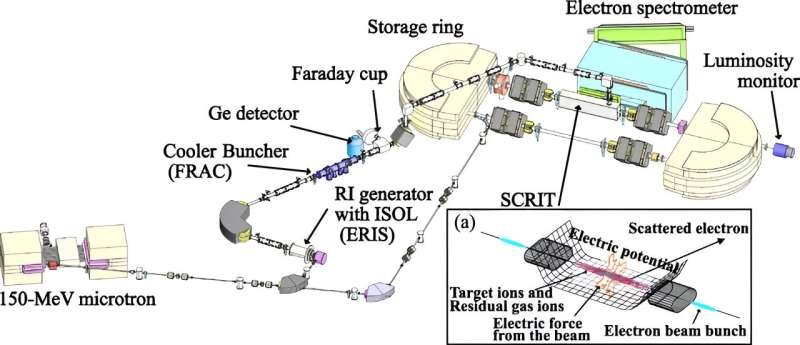In a significant milestone for nuclear physics and particle science, researchers have accomplished an unprecedented feat by observing electron scattering from radioisotopes that do not occur naturally. This groundbreaking achievement opens new avenues for understanding the fundamental properties of matter and the universe’s underlying forces.
The study, conducted by a team of scientists from diverse fields, brings together elements of nuclear physics, particle accelerators, and advanced detection techniques. Their efforts have culminated in a remarkable discovery that pushes the boundaries of our understanding of subatomic particles.
Radioisotopes, which are unstable forms of atoms with excess nuclear energy, have been a subject of scientific fascination for decades. They are commonly used in various fields, including medicine, industry, and environmental monitoring. Until now, researchers have primarily studied naturally occurring radioisotopes or those produced in nuclear reactors. The ability to observe electron scattering from non-naturally occurring radioisotopes represents a significant leap forward in our knowledge of nuclear physics.
The experiment involved the use of a state-of-the-art particle accelerator, which provided the high-energy electrons required for the study. These accelerated electrons were directed at a target containing artificially created, short-lived radioisotopes. The high-energy electrons interacted with the radioisotopes, leading to the scattering of electrons in various directions.
One of the critical aspects of this experiment was the development of ultra-sensitive detectors capable of capturing the scattered electrons’ trajectories and energies with exceptional precision. These detectors were meticulously designed and calibrated to handle the fleeting and high-energy nature of the scattering events.
The results of the study were nothing short of astonishing. Researchers were able to observe the intricate details of electron scattering from these non-natural radioisotopes, shedding light on the inner workings of atomic nuclei and their constituent particles. The data collected during the experiment will undoubtedly have far-reaching implications for our understanding of nuclear structure and the fundamental forces governing the universe.
This breakthrough has the potential to impact various scientific disciplines, including astrophysics, where knowledge of nuclear reactions is crucial for understanding the processes occurring within stars and other celestial bodies. It may also have implications for the development of advanced nuclear technologies and could contribute to our understanding of the early moments of the universe, shortly after the Big Bang.
Furthermore, the successful observation of electron scattering from non-natural radioisotopes highlights the importance of interdisciplinary collaboration in modern scientific research. Experts from diverse fields came together to achieve this milestone, emphasizing the need for a holistic approach to tackling complex scientific challenges.
The recent breakthrough in observing electron scattering from non-naturally occurring radioisotopes marks a pivotal moment in the field of nuclear physics. As researchers delve deeper into the implications of this discovery, several exciting avenues of exploration and applications emerge.
- Nuclear Structure: One of the primary areas of interest lies in the realm of nuclear structure. The data collected from this experiment provides valuable insights into the arrangement and behavior of particles within atomic nuclei. This newfound knowledge can lead to a more comprehensive understanding of nuclear forces and the behavior of protons and neutrons under extreme conditions.
- Nuclear Astrophysics: Understanding nuclear reactions is crucial in the study of astrophysical phenomena. The conditions within stars, supernovae, and neutron stars involve extreme temperatures and pressures that can only be comprehended by delving into the intricacies of nuclear physics. The insights gained from this research will undoubtedly contribute to our knowledge of these cosmic events.
- Advanced Nuclear Technologies: The field of nuclear technology stands to benefit from this breakthrough. Innovations in nuclear reactors, particle accelerators, and other applications may arise from a deeper understanding of nuclear interactions. These developments could lead to more efficient and safer nuclear technologies, potentially addressing challenges related to energy production and nuclear waste disposal.
- Cosmic Origins: The observations made in this experiment could also provide clues about the universe’s early moments after the Big Bang. By studying the behavior of particles under extreme conditions, scientists may gain valuable insights into the processes that shaped the universe in its infancy.
- Interdisciplinary Collaboration: The success of this research underscores the importance of interdisciplinary collaboration in scientific endeavors. By bringing together experts from various fields, this breakthrough serves as a testament to the power of teamwork and shared knowledge.
As researchers continue to analyze the wealth of data collected during this experiment, new questions will undoubtedly arise, sparking further investigations into the fascinating world of nuclear physics. The journey to understand the fundamental forces that govern our universe is an ongoing one, and each breakthrough takes us one step closer to unraveling the mysteries of the cosmos.
In conclusion, the observation of electron scattering from non-naturally occurring radioisotopes is a milestone that resonates far beyond the realm of nuclear physics. It offers a glimpse into the intricate dance of subatomic particles, provides insights into astrophysical phenomena, and holds promise for advancements in nuclear technology. This achievement exemplifies the relentless pursuit of knowledge and the boundless potential of scientific exploration. As researchers continue their quest to uncover the secrets of the universe, the future of nuclear physics is poised for even more exciting discoveries.




































